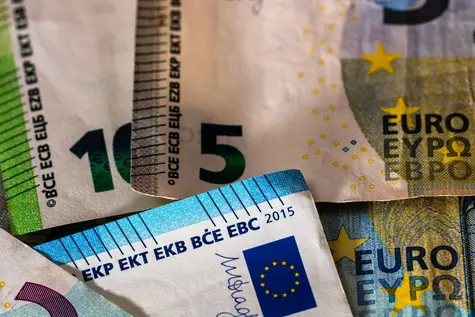
Germany’s Economy: Three Years of Stagnation With Only Limited Signs of Recovery
Same old story: Germany’s longest stagnation has now been confirmed. The economy will remain stuck until fiscal stimulus begins to take effecta

Same old story: Germany’s longest stagnation has now been confirmed. The economy will remain stuck until fiscal stimulus begins to take effecta

A December Fed cut is back as a baseline scenario for markets, but the dollar has remained relatively strong. Our short-term valuation metrics point to significant risks of a USD correction, unless data prompts a hawkish repricing. Geopolitics will remain in focus, both for European FX (Ukraine peace talks) and the yen (Japan-China tensions over Taiwan)


This week, we should see more economic data from the region after a rather quiet last week.

It could have been a lot worse for EUR/USD this week. A set of FOMC minutes that poured cold water on a December rate cut and a strong headline rise in the US jobs report could have seen 1.1500 taken out again. But instead, investors seemed to have just delayed rather than abandoned pricing for Fed easing. And Europe may still being showing some signs of life

Global markets are trading in a slightly nervous fashion as they brace themselves for a potential correction in US tech stocks. So far, the correction has been modest compared to the 25% fall in bitcoin, but events over the next 24 hours will have a say in whether moves extend. We'll have FOMC minutes, Nvidia earnings and the September jobs reporta

Tepid pricing in the industry and weakening price dynamics in agriculture are a downward risk for consumer prices. If consumer spending remains steady, inflation is likely to hover around the target over the upcoming year. A combination of factors might result in a low-inflation environment

Next week, we’ll be watching for September’s delayed US jobs report and the release of October's more hawkish Fed minutes, which could dampen hopes for a December rate cut. We also expect the National Bank of Hungary to hold rates while signalling they’ll remain high for some time, with the release of Czech PPI data also due

Earlier this summer, German Chancellor Friedrich Merz promised a 'Fall of reforms'. This week, the government moved to accelerate decision-making, unveiling a fresh set of policy announcements within just the past 24 hours

South Korea’s jobless rate rose in October, but it remains below 3%. The Bank of Korea is expected to keep policy unchanged in November amid concerns about property risk and volatile foreign exchange markets

It has been a mixed week for the dollar, where early-week strength finally eased a little yesterday on indications of softer US jobs data. Yet with the US government shutdown ongoing, we are still in the dark about the true labour market picture. Expect more $ consolidation and focus on regional stories such as soft China trade data and the Canada jobs release

In the Eurozone, ECB’s Schnabel sees money market rates rising as system reserves decline, with banks then turning to the ECB for liquidity. It is part of the plan and could happen in mid-2026, but is more likely to happen later. Meanwhile, US Treasuries are being buffeted by contrasting impulses. It's been quite a week, but we broadly end where we started

As expected, NBP policymakers delivered their fourth consecutive 25bp rate cut in November, extending the scale of monetary easing this year to 150bp. Rate-setters reacted to lower current inflation, but may pause before a final adjustment to monetary policy. We see two more cuts in the first half of next year, with the target rate at 3.5-4% in 2026

The risk mood has darkened a little this week, with some sizeable corrections emerging in some equity markets. There has not been one catalyst per se, but lofty valuations must be leading to some profit-taking in uncertain conditions. For today, it's all about the US ADP jobs release and what it means for the December Fed meeting. Expect FX to stay defensive

The National Bank of Poland (NBP) has repeatedly warned of upside risks to inflation over the medium term, but this has not prevented the central bank from cutting rates as inflation moderates. Rate-setters have cut rates at each policy meeting since July, and we expect another 25bp cut on 5 November

Yesterday's PMI showed a mixed picture in the region, with the Czech Republic's lower-than-expected, while Poland and Hungary surprised with higher-than-expected readings. Inflation in Turkey surprised the market lower (2.6%/32.9%), in line with our estimate, and inflation returned to a declining trajectory.

The slew of post-meeting ECB speakers has added little to the policy narrative. The Governing Council is broadly on the same page with the rates view, and the feeling is that some substantial data surprises are now needed to create new division among policymakers.

FX markets are struggling to find direction this week. The Fed’s doubts on whether to cut in December naturally increase scrutiny of data: this means both depressed volatility during data silence and some potential exacerbation of USD reaction to any labour indicator (like tomorrow’s ADP). Our call remains that the dollar is close to its peak

US Treasury yields look like they want to nudge higher when they can. And why not, as corporate earnings are firm, and hard macro data is being kept under shutdown wraps. New lows in euro rate volatility help spreads on European government bonds (EGBs) tighten further. Given the spread tightness, Bunds look increasingly attractive as a risk hedge

The UN climate conference in Belém has ignited a fierce debate and highlighted serious climate policy hurdles, before it has even begun. Despite these challenges, we see COP30 as a pivotal opportunity for meaningful boardroom conversations on carbon markets, sustainable finance and renewables

Italy's October inflation numbers show a marked deceleration. This is very much an energy and fresh food story, against stable core inflation. As we don’t expect an imminent change to the pattern, we're trimming our forecast for average 2025 headline inflation to 1.6%

PEC+ is scheduled to meet this weekend, with the expectation that the group will agree on an output hike for December

Higher-than-expected Japanese inflation in October, together with improvements in production and retail sales, suggests growth is bottoming out toward quarter-end, while price pressures continue to intensify. The Bank of Japan may consider an earlier rate increase

The dollar enjoyed a second round of support yesterday as Powell's relatively hawkish press conference continued to resonate with data-starved markets. But the conditions for another big leg higher in USD aren't there, in our view. Meanwhile, Japan has intervened verbally to curb JPY volatility, and GBP is looking closely at Reeves' political position

Spain’s economy grew by 0.6% over the third quarter, following a robust second quarter, as external demand weakened. With signs of cooling in industrial activity and tourism, growth is expected to normalise over the coming quarters and into 2026

We expect a 25bp Fed cut today, in line with pricing and consensus. In September, a similar setting from a pricing perspective prompted a sharp dollar rebound. Now, with positioning more balanced and inflation looking better, it’s harder to see the same reaction. We expect some CAD weakness as the Bank of Canada should also cut by 25bp today

EUR/USD has nudged through resistance at 1.1650 in quiet markets. The softer dollar has been the driver, although we wonder whether some compromise on the French budget is helping too.

The oil market continues to digest the potential impact of US sanctions on Russian oil producers. Meanwhile, the risk of sanctions continues to provide a boost to middle distillates


Our economics team expects Wednesday's UK services inflation to undershoot the BoE's projection with a 4.6% read, which is also below the 4.8% consensus. That can modestly move the needle to the dovish side in the GBP swap curve and weigh on the pound this week.

The eurozone calendar is empty until Friday’s PMI and EUR/USD moves will primarily depend on market sentiment about the US credit market. What is important to note is that EUR/USD is spot on its short-term fair value (1.167) despite the recent rally.

As Jamie Dimon warned, there may be more ‘cockroaches’ (i.e. distressed lenders) out there after two US regional banks reported credit issues last week. Markets will be looking very closely for evidence of that, and the dollar continues to face substantial downside risks. Later this week, US CPI should not come in hot enough to derail Fed easing plans

FinancialMarkets.media proudly announces that its Chairman & Founder, Francesc Riverola, has been awarded an Honorary Membership from the Society of Technical Analysts Limited (STA), one of the most prestigious institutions in the world of Technical Analysis.

China's exports continued to beat forecasts in September, but the bigger surprise was the surge of imports to hit a 17-month high. This resilience shows that China has strengthened trade with the rest of the world amid US protectionisma

VirPoint is a relatively young CFD (Contracts for Difference) broker that focuses on price transparency, speed of operation, and the ability to trade multiple asset classes from a single account. The company claims to have been founded in 2020 and to operate using modern security technologies. In this review, we will look at what is known for sure and what advantages and disadvantages the service provider has.

We have revised our gold forecast higher. Again

Recent headlines from France offer cautious optimism, with markets showing unexpected resilience despite domestic turmoil and broader uncertainties like the US shutdown. In European bonds, recouping the foreign investor shares after QE is not yet complete, although it can be a source of volatility

Log in to today's North American session Market wrap for October 6th
The week opens on the typical 2025 trade: Metals, propelled by Gold (1.90%) and Palladium (4.50%!), Cryptocurrencies, and Tech rage higher.

A week dominated by central bank communications and seasonal dynamics kept investors on edge, even as the UN General Assembly passed without major geopolitical surprises except for some memorable US President Trump quotes.

The economy remains on track to see a small improvement in GDP growth in the third quarter as uncertainty fades and big shocks to trade have been avoided

You may be familiar with the hit teatime game show Pointless. And it's got me thinking. After a surprise rate cut from Sweden's Riksbank and, as the Fed kicks off its own easing cycle, will any of it make a difference? It's complicated, of course, but hopefully entertaining. Fingers on buzzers as we look ahead to another jackpot week in financial markets

The British Pound has continued its recent malaise against the US Dollar after a stellar rally ahead of the US interest rate decision. Since the decision, Cable has been on a downward trend as the US Dollar has continued to gain traction.

The dollar is a little stronger as investors reassess the immediacy of a US slowdown and what it means for interest rates. One early highlight for Europe is the Swiss National Bank meeting. Hardly anyone expects the policy rate to be cut into negative territory, but the franc remains strong and the SNB could try tweaking rates on excess reserves

The Australian dollar is coming off its best week since July, with gains of close to 1%. In Monday's European session, AUD/USD is trading at 0.6589, down 0.07% on the day.

The currency market had been dormant for a while, but this is now a theme of the past yet again.
Throughout August, a first move higher from the Pound got met with a subsequent consolidation until the beginning of this month .

Inflation is more or less at a peak, though it's likely to stay in the 3.5-4% area for the rest of this year. Rising food inflation is a particular bugbear of the Bank of England. Yet we aren't in the camp that thinks rate cuts are over, given the prospect of further progress in services inflation and wage growth

After a couple of months of stability, we look for the dollar bear trend to resume into year-end. EUR/USD should be trading up at 1.20 by that stage after three Fed rate cuts. Even though valuations look stretched in equity and credit markets, we still prefer a benign decline in the dollar and a supported environment for risk assets and activity currencies

Valetax made a significant mark at Money Expo India 2025 as a Diamond Sponsor, joining India's premier financial gathering on 23–24 August at Mumbai's Jio World Convention Centre. The event served as a strategic cornerstone to cultivate meaningful partnerships, decode regional market opportunities, and underscore its unwavering commitment to India's financial ecosystem as a key pillar of its Asian market expansion.

The dollar has found a little support at the start of the week. Chinese authorities have now turned to fixing USD/CNY a little higher, which removes one of the dollar's negative impulses from last week. The highlight of an otherwise quiet session will be today's eurozone flash CPI release for August and the US ISM business confidence data

The MPC wraps up its first post-summer holiday meeting on 3 September, and we expect a 25bp rate cut as policymakers attempt to adjust the monetary stance to lower inflation. As we see inflation sustainably returning to target, we’re still pencilling in another cut later in the year, likely in November

After today's Labor Day holiday, this week's US calendar is packed with labour market data, culminating in Friday's August jobs report. Elsewhere, investors don't quite know what to make of an appeals court ruling Trump's universal tariffs illegal. Could it be a story of lost revenues weighing on the Treasury market? We expect the dollar to stay soft

Chinese equities hit a fresh three-year high, while India's Nifty 50 rebounded on Monday after President Xi Jinping and Prime Minister Narendra Modi attended a weekend summit in Shanghai alongside leaders from Russia, Iran and Turkey. The meeting focused on strengthening ties among emerging markets in the face of what participants described as aggressive US trade policies.

Lisa Cook is challenging her dismissal in court, and markets are seemingly staying away from pricing in any substantial dovish shifts at the FOMC beyond what can be derived from data and Powell’s remarks. But the dollar’s downside risks have increased, even if that won’t show in the near term. Today’s focus will be on inflation data in the US and eurozone

The Bangko Sentral ng Pilipinas (BSP) lowered its policy rate by 25bp to 5.00%, signalling a neutral stance amid stable inflation and slowing – but resilient – growth. While the easing cycle is nearing its end, one final rate cut this year remains likely, given our view of weaker GDP growth in the second half of the year

The Australian dollar is showing limited movement on Tuesday. In the European session, AUD/USD is trading at 0.6482, down 0.01% on the day.

It’s becoming increasingly clear that Trump’s dismissal of Lisa Cook is not going to have a big short-term FX impact. The implications may only play out in the longer run, as the current focus remains more on data. French politics also appears to be treated with plenty of caution by the currency market. We think EUR/USD can stabilise today

A mild miss in last week’s July inflation figures provided a bit of support for the Canadian dollar, which posted weekly gains against most other G10 currencies.

In a quiet week for FX markets, the dovish rate cut from the Reserve Bank of New Zealand overnight shows the importance of spare capacity in the economy as the central bank looks through a short-term rise in inflation. It looks like it's going to be a quiet day in G10 FX, although sterling and the Swedish krona will be reacting to CPI and the Riksbank

Disciplined execution on M15 with confirmed pullbacks, indicator support, and a one trade at a time policy.

Yesterday’s summit in Washington resulted in a clearer roadmap for peace talks and some openness about security guarantees from the US. But the euro was offered as news flowed, perhaps on the view that the bulk of key territorial negotiations are still ahead of us. US macro developments remain a bigger driver for EUR/USD, which still faces upside risks

Risk-prioritized Expert Advisor with defined exits, broker-side safeguards, and configurable exposure for volatile conditions.

M30 Expert Advisor for EURUSD that combines pattern recognition with false-breakout screening to standardize entries and exits.

MetaTrader 4 Expert Advisor for XAU/USD that pairs pattern recognition with round-the-clock monitoring and rule-based execution

MT4 Expert Advisor for XAU/USD on H1, combining indicator-led confirmation with a swing-oriented, rules-driven workflow.

Wave-pattern detection paired with technical confirmation for XAU/USD; defined exits, trailing stops, slippage filters, and global safeguards.

Pattern detection and data analysis for XAU/USD, turning recurring price structures into a disciplined execution flow.

Customizable Expert Advisor for XAU/USD that switches tactics as conditions change, pairing layered analysis with rule-based execution.

Automated system for XAU/USD that turns candlestick reading into a rule-based workflow on the four-hour chart.

MT4 Expert Advisor for XAUUSD and GBPUSD on M30; pattern-led entries confirmed by trend and momentum, with demo available.

MT4 Expert Advisor for XAU/USD that automates pattern detection and routes decisions through clear, rule-based execution.

MT4 Expert Advisor with candlestick-based analysis and rule-driven execution on M15; demo available for evaluation.

ile stocks continue to hit new highs, the worldwide sell-off in long-term government bonds is gathering pace. Rates actually rose more in nearly every G10 country than they did in the US last week, which certainly contributed to dollar weakness.

US Secretary Bessent said the Fed should cut by 50bp in September, and that rates are 150-175bp above where they should be. Markets aren’t considering a 50bp move as an option, and we doubt they will unless there are hints in that direction from Fed members or if the jobs data falls much further. Today, Norges Bank should hold rates, with some minor hawkish risk

After a rough month of July taking the most traded Major pair from 1.1830 highs to a 4-handle correction, the NFP report at the beginning of the month led a huge wave of higher mean-reversion – An end-July daily double top on the pair had brought fresh technical fuel to sell the Euro.

The British pound is showing limited movement on Monday. In the European session, GBP/USD is trading at 1.3455, up 0.05% on the day.
The Bank of England is keeping a close eye on two key fronts as it charts a rate path - inflation and employment. The BoE lowered rates last week in a decision that raised a lot of eyebrows since it took an unprecedented two rounds of voting to reach the decision. The close 5-4 vote points to dissension among MPC members as how best to proceed.

We expect a 0.4% month-on-month core CPI print in the US today, above the 0.3% consensus. That should offer the dollar support, but we don’t think that will prompt markets to seriously price out a September cut, meaning we can see decent buying in the EUR/USD dips. Headlines on upcoming US-Russia-Ukraine talks also remain relevant for markets

Earlier last week, the USD/JPY surged to a four-month high of 150.92 on 1 August, but its prior accumulated gains of the previous four sessions were all wiped out and formed a weekly bearish “Shooting Star” at the close of last Friday, 1 August US session.

The same day President Trump installed an (interim) dovish ally in the FOMC, the Bank of England struck a more hawkish tone, narrowly voting in favour of another 25bp rate cut. The US calendar is very quiet today, and some focus will be on Canada’s jobs figures. EUR/USD may wait until next week for a break above 1.170

US President Donald Trump appears to be advancing efforts to broker a Russia-Ukraine truce. Markets are pricing in cautious optimism: oil, dollar, and the Swiss franc all came under pressure. CHF remains vulnerable amid the collapse of US-Switzerland trade talks. The Bank of England is widely expected to cut rates today, but don’t expect any dovish shift

A typical summer trading session with most asset classes trading in tight ranges. USD ticked higher though on low volumes, while equity sentiment holds higher, boosted by tech earnings. Fed's Daly said disappointing jobs data, and limited tariff impact on inflation mean we may need more than two rate cuts which drove UST flattening on Monday, which has since reversed.

One could be forgiven for thinking that President Trump has now turned his attention to disassembling the BRICS political grouping. India, Russia and Brazil are squarely in focus currently. And benign market conditions in August clearly rely on no deterioration in the current US-China detente. Away from geopolitics, the focus today is on US ISM services

The first four days of the week were characterised by a broad dollar rally, as a solid GDP report, the signing of trade deals and a hawkish Fed acted to chip away at the greenback’s risk premium.

Following Friday's soft US jobs report, the dollar looks to stay offered this week. The firing of the Bureau of Labor Statistics chief, after President Trump accused the agency of manipulating jobs data for political gain, also adds pressure. And the early resignation of Fed Governor Adriana Kugler – opening up the pick for Powell's successor – won't help

As discussed in the USD section, new 'reciprocal' tariffs are having little market impact. Canada deserves special attention in our view, though, especially after Mexico secured another pause extension yesterday.

The US has announced new 'reciprocal' tariffs (Canada, Switzerland and New Zealand are notable targets) while keeping the base rate at 10%. The muted market impact signals lingering expectations of trade deals and the much greater focus on data. Today, we expect payrolls at 115k and unemployment at 4.2%, which could lead to some consolidation of USD gains

Despite two dissenting votes, the Fed delivered a broadly hawkish hold, with Chair Powell remaining firm on his inflation call and forcing markets to trim September cut bets. The dollar’s rally may have a bit more to run as today’s core PCE figures may come in above consensus and tomorrow’s jobs figures prove good enough to endorse the Fed’s prolonged pause

South Korea reached a 15% tariff deal with the US, committing $350 billion in investments and buying $100 billion in US LNG and other energy imports. While some specifics remain unclear, the deal broadly aligns with expectations and has been positively received by markets

China's Politburo meeting showed that the policy stance will remain supportive while continuing to emphasise the recent focus on building domestic demand, supporting the hardest hit exporters, and addressing China's difficult "involution" problem. All eyes will now be on China's Fourth Plenum and the upcoming 15th Five Year Plan

The Canadian dollar has dropped less than other G10 currencies during this round of USD appreciation. For the moment, domestic factors aren’t playing much of a role, and markets remain quite conservative on Bank of Canada rate cuts, pricing in only 15bp by year-end.

The biggest takeaway from yesterday's sell-off in the euro was that some of this year's highest conviction trades were becoming a little stale. EUR/USD has already had a decent correction even before this week's negative event risks. Expect investors to remain cautious. For today, we'll be focusing on US JOLTS data and some European GDP data

The agreement on the long-awaited US-Japan trade deal should be good news for the yen. The deal will see 15% tariffs imposed on most sectors, including the country's all-important autos industry, lower than the 25% recently threatened by the White House.

The announcement of a US-EU trade deal has lifted equity futures on both sides of the Atlantic. Investors are more worried about a bubble now than a recession. The deal takes some pressure out of the 1 August tariff deadline and shifts the focus back to a very busy week of macro data. Here, we think the Fed meeting, inflation and jobs data can support the dollar

Interest rates have moved higher around the world as equity markets rally on a sense of optimism. The biggest factor behind that this week has probably been the US-Japan trade deal and the sense that a US-EU deal is close too. ECB President Christine Lagarde added to that trend yesterday with a more upbeat take on activity. Expect the euro to stay supported

The yen has continued to strengthen overnight, remaining the best performer in G10 since the start of the week, up 1.8% against the dollar. The US-Japan trade deal is seemingly reinforcing market expectations on a Bank of Japan rate hike by the end of the year, which is now 20bp priced in, up from 16bp earlier this week and a 10bp low earlier in July.

European markets have opened to news of a US-Japan trade deal. Equity markets globally are rallying on the view that deals reduce uncertainty. The yen, however, is less certain of what this all means – especially given the prospect of an imminent resignation from PM Ishiba. Elsewhere, commodity currencies continue to do well as industrial metals rally

We would not read too much into the marginal strengthening of the yen after Sunday's Upper House election result in Japan. Uncertainty is certainly on the rise here. For the week ahead, we have rate meetings in the eurozone, Hungary and Turkey, plus new business confidence readings in Europe. A new dam project in China also looks exciting for commodity FX

Retail sales and jobless claims were better than expected yesterday, offering more support for a hawkish rethink of Federal Reserve rate cuts. We expect the residual 14bp priced in for September to be gradually reduced and add pressure on EUR/USD. Elsewhere, Japan’s election on Sunday might trigger a break above 150.0 in USD/JPY


Yesterday’s US inflation failed to validate dovish bets on the Fed and triggered a bounce in the oversold dollar. We see more room for hawkish repricing in the coming weeks, and accordingly, upside risks for USD. Today, the US PPI and the Fed Beige Book are in focus. In the UK, services CPI came in hotter than expected, but tomorrow’s jobs data will be key for GBP

Bank Indonesia’s rate cut today surprised markets, but the overnight announcement of a trade deal with Indonesia by President Trump likely provided the confidence needed to proceed without delay. We continue to anticipate an additional 50 basis points of rate cuts by the first quarter of 2026